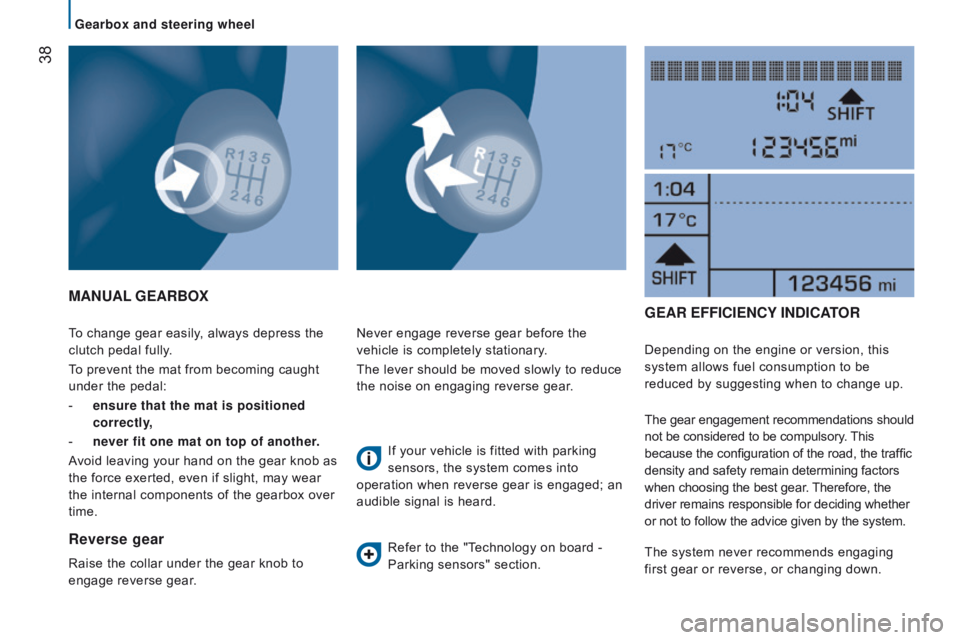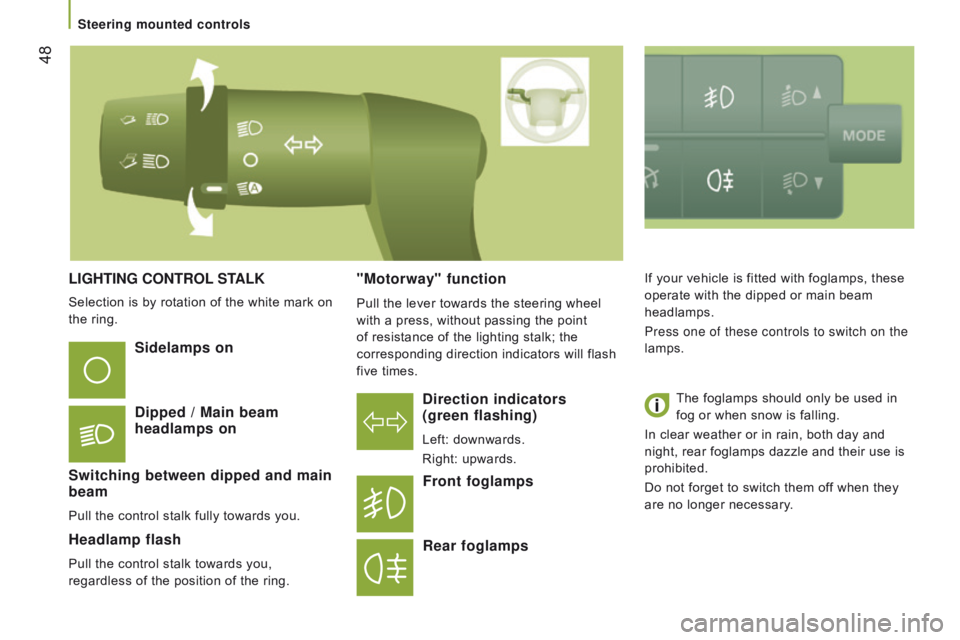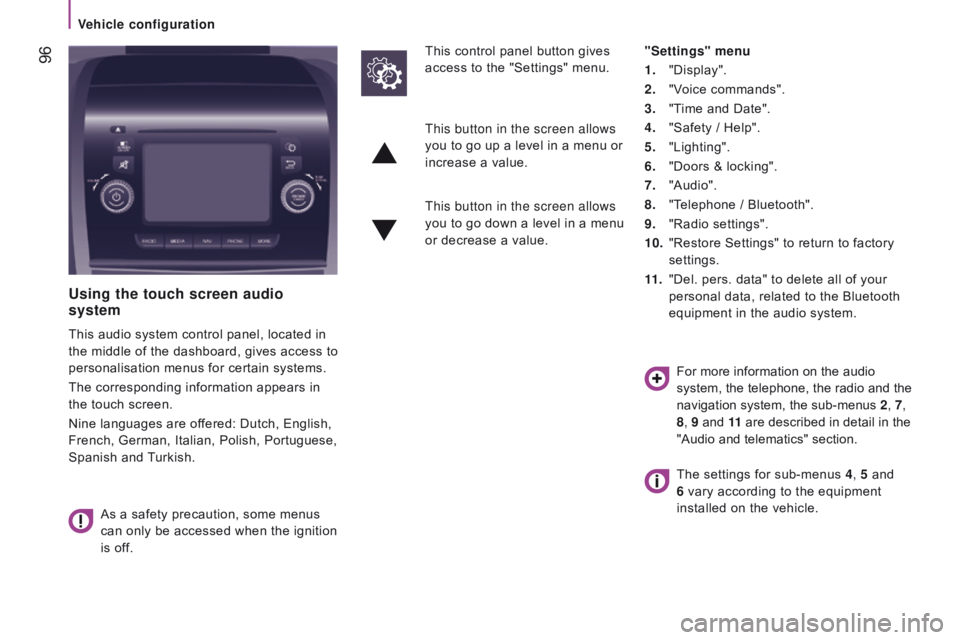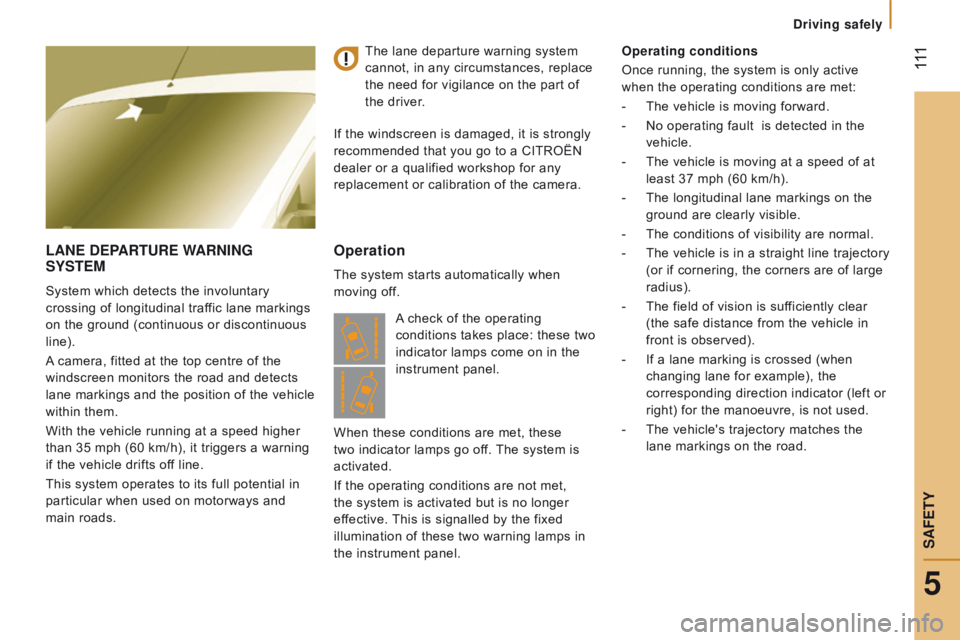ESP CITROEN RELAY 2017 Handbook (in English)
[x] Cancel search | Manufacturer: CITROEN, Model Year: 2017, Model line: RELAY, Model: CITROEN RELAY 2017Pages: 292, PDF Size: 9.04 MB
Page 22 of 292

20
FrOnt dOOrSc hild lock
This prevents opening of the sliding side
door from the inside.
Press the control located on the edge of the
side door.
Use the corresponding button on the remote
control or use the key in the driver's door
lock barrel to unlock.
Pull the handle towards you.
SLIdInG SIdE dOOr
Take care not to obstruct the guide space
on the floor in order for the door to slide
correctly.
From outside
Pull the handle towards you then towards
the rear.
From inside
To unlock and open, push the handle
towards the rear.
Ensure that the door opens fully in order
for the latch at the bottom of the door to
engage.
To release and close, pull the handle while
sliding the door.
Do not drive with the sliding side door
open.
Access
Page 40 of 292

38
To change gear easily, always depress the
clutch pedal fully.
To prevent the mat from becoming caught
under the pedal:
-
ensure that the mat is positioned
correctly,
-
never fit one mat on top of another
.
Avoid leaving your hand on the gear knob as
the force exerted, even if slight, may wear
the internal components of the gearbox over
time.
MAnuAL GEA r BO x
r
everse gear
Raise the collar under the gear knob to
engage reverse gear. Never engage reverse gear before the
vehicle is completely stationary.
The lever should be moved slowly to reduce
the noise on engaging reverse gear.
If your vehicle is fitted with parking
sensors, the system comes into
operation when reverse gear is engaged; an
audible signal is heard.
Refer to the "Technology on board -
Parking sensors" section.
GEAr EFFIcIEncY IndIcAtO r
Depending on the engine or version, this
system allows fuel consumption to be
reduced by suggesting when to change up.
The gear engagement recommendations should
not be considered to be compulsory. This
because the configuration of the road, the traffic
density and safety remain determining factors
when choosing the best gear. Therefore, the
driver remains responsible for deciding whether
or not to follow the advice given by the system.
The system never recommends engaging
first gear or reverse, or changing down.
Gearbox and steering wheel
Page 50 of 292

48
LIGHtInG cOntrOL S tALK
d irection indicators
(green flashing)
Left: downwards.
Right: upwards.
Sidelamps on
d
ipped / Main beam
headlamps on
Switching between dipped and main
beam
Pull the control stalk fully towards you.
Headlamp flash
Pull the control stalk towards you,
regardless of the position of the ring.
Front foglamps
r
ear foglamps
If your vehicle is fitted with foglamps, these
operate with the dipped or main beam
headlamps.
Press one of these controls to switch on the
lamps. The foglamps should only be used in
fog or when snow is falling.
In clear weather or in rain, both day and
night, rear foglamps dazzle and their use is
prohibited.
Do not forget to switch them off when they
are no longer necessary."Motorway" function
Pull the lever towards the steering wheel
with a press, without passing the point
of resistance of the lighting stalk; the
corresponding direction indicators will flash
five times.
Selection is by rotation of the white mark on
the ring.
Steering mounted controls
Page 52 of 292

50AutOMAtI c HEA d LAMP d IPPI n G
System which automatically changes to main
beam according to the ambient light level
and the driving conditions, using a camera
located at the top of the windscreen
This system is a driving aid.
The driver remains responsible for
the vehicle's lighting, its correct use for the
prevailing conditions of light, visibility and
traffic and observation of driving and vehicle
regulations.
Steering mounted controls
Page 62 of 292

60
SPEEd LIMItEr
"This is the selected speed which the driver
does not wish to exceed".
This selection is made with the vehicle
stationary and the engine running or with the
vehicle moving and 2
nd gear or higher engaged.
The lowest speed that can be programmed is
20 mph (30 km/h).
The speed of the vehicle responds to the
pressure of the driver's foot as far as the
accelerator pedal point of resistance which
indicates that the programmed speed has been
reached. However, pressing the pedal beyond this
point of resistance to the floor permits
exceeding of the programmed speed. To
resume use of the limiter, simply reduce
the pressure on the accelerator pedal
gradually and return to a speed below that
programmed.
t
he operating actions may be carried out
with the vehicle stationary and the engine
running, or with the vehicle moving. This speed limiter shows the status of the
system and the programmed speed in the
instrument panel screen:
System selected,
display of the "Speed
Limiter" indicator.
System deactivated,
last programmed speed - OFF
(example at 65 mph
(107
km/h)).
System activated
(example at 65 mph
(107 km/h)).
Vehicle speed above
(example 70 mph
(118
km/h))
the programmed speed is
displayed flashing.
Operating fault detected,
OFF - the dashes flash.
Steering mounted controls
Page 75 of 292

73Immediate heating
Before switching on the heating, check that:
-
the temperature setting control is in the
"Hot air" position (red),
-
the air flow setting control is in
position
"2"
. The
"- -:- -" symbol or the
previous stored time and the
number (1, 2 or 3) corresponding
to the recalled pre-selection are
displayed for ten seconds.
n
ote: if you wish to recall the other pre-
selected times, press the "set" button
repeatedly before the ten seconds have
elapsed.
Press this button.
The screen and the heating cycle
indicator come on and remain
on throughout the duration of
operation.
deferred heating
Switching on can be programmed between
one minute and twenty-four hours in
advance.
You can store up to three different start
times, but programme one deferred start
only.
n
ote: if you wish to start the heating at a
fixed time each day, simply reprogramme
the stored time each day.
Press the "set" button, the
screen comes on. Within ten seconds, press the "<"
or ">"
setting button to select the
required start time.
Setting of the stored time is confirmed by
clearing of the start time, displaying of
the pre-selection number (1, 2 or 3) and
illumination of the screen.
By default, pre-selected times are
already memorised in the system
(1
= 6 hours; 2 = 16 hours; 3 = 22 hours).
Any modification cancels and replaces the
previous pre-selected time.
If the battery is disconnected, the default
pre-selected times are restored.
cancelling the programming
Press the "set" button briefly to
clear the programmed start time.
The screen illumination and the
pre-selection number (1, 2 or 3)
go off.
recalling one of the pre-selected
start times
Press the "set" button as many
times as necessary until the
number corresponding to the
required pre-selected start
time
(1, 2 or 3) appears.
After ten seconds, the time disappears but
remains stored while the corresponding
number (1, 2 or 3) and the screen
remain
on.
3
EASE OF uSE and cOMFOrt
Ventilation
Page 94 of 292

92PErSOnALISAtIO n - cO n FIG ur At IO n
u
sing the MO d E control panel
This control panel located alongside the
steering wheel provides access to menus for
the personalisation of some of the vehicle
systems.
The corresponding information appears in
the instrument panel screen.
Eleven languages are offered: Brazilian,
Dutch, English, French, German, Italian,
Polish, Portuguese, Russian, Spanish and
Turkish. You have access to all the menus if your
vehicle is fitted with an audio system.
If your vehicle is fitted with a touch screen
audio system, certain menus are only
accessible using the audio system control
panel.
-
scroll down through a menu,
-
decrease a value.
t
his MO d E button enables you to:
-
access the menus and sub-menus,
-
confirm your selections, within a
menu,
-
quit the menus.
A
long press takes you back to the
home screen.
t
his button enables you to:
t
his button enables you to:
-
scroll up through a menu,
-
increase a value.
As a safety measure, some menus can
only be accessed when the ignition is off.
Vehicle configuration
Page 98 of 292

96
using the touch screen audio
system
This audio system control panel, located in
the middle of the dashboard, gives access to
personalisation menus for certain systems.
The corresponding information appears in
the touch screen.
Nine languages are offered: Dutch, English,
French, German, Italian, Polish, Portuguese,
Spanish and Turkish.
As a safety precaution, some menus
can only be accessed when the ignition
is off. This control panel button gives
access to the "Settings" menu.
"Settings" menu
1.
"Display".
2.
"V
oice commands".
3.
"T
ime and Date".
4.
"Safety / Help".
5.
"Lighting".
6.
"Doors & locking".
7.
"Audio".
8.
"T
elephone / Bluetooth".
9.
"Radio settings".
10.
"Restore Settings" to return to factory
settings.
11 .
"Del. pers. data" to delete all of your
personal data, related to the Bluetooth
equipment in the audio system.
This button in the screen allows
you to go up a level in a menu or
increase a value.
This button in the screen allows
you to go down a level in a menu
or decrease a value.
For more information on the audio
system, the telephone, the radio and the
navigation system, the sub-menus 2, 7,
8 , 9 and 11 are described in detail in the
"Audio and telematics" section.
The settings for sub-menus 4 , 5 and
6 vary according to the equipment
installed on the vehicle.
Vehicle configuration
Page 113 of 292

111
LAnE dEPArturE WArn I n G
S YS t EM
System which detects the involuntary
crossing of longitudinal traffic lane markings
on the ground (continuous or discontinuous
line).
A camera, fitted at the top centre of the
windscreen monitors the road and detects
lane markings and the position of the vehicle
within them.
With the vehicle running at a speed higher
than 35 mph (60 km/h), it triggers a warning
if the vehicle drifts off line.
This system operates to its full potential in
particular when used on motorways and
main roads.
Operation
The system starts automatically when
moving off. Operating conditions
Once running, the system is only active
when the operating conditions are met:
-
The vehicle is moving forward.
-
No operating fault
is detected in the
vehicle.
-
The vehicle is moving at a speed of at
least 37 mph (60 km/h).
-
The longitudinal lane markings on the
ground are clearly visible.
-
The conditions of visibility are normal.
-
The vehicle is in a straight line trajectory
(or if cornering, the corners are of large
radius).
-
The field of vision is suf
ficiently clear
(the safe distance from the vehicle in
front is observed).
-
If a lane marking is crossed (when
changing lane for example), the
corresponding direction indicator (left or
right) for the manoeuvre, is not used.
-
The vehicle's trajectory matches the
lane markings on the road.
The lane departure warning system
cannot, in any circumstances, replace
the need for vigilance on the part of
the
driver.
If the windscreen is damaged, it is strongly
recommended that you go to a CITROËN
dealer or a qualified workshop for any
replacement or calibration of the camera.
A check of the operating
conditions takes place: these two
indicator lamps come on in the
instrument panel.
When these conditions are met, these
two indicator lamps go off. The system is
activated.
If the operating conditions are not met,
the system is activated but is no longer
effective. This is signalled by the fixed
illumination of these two warning lamps in
the instrument panel.
5
driving safely
SAFEtY
Page 117 of 292

115
trAFFIc SIGn rEcOGnItIOn
This system is a driving aid that make
use of a camera located at the top of the
windscreen.
The camera detects the following types of
traffic signs and displays the corresponding
information in the instrument panel:
-
speed limits,
-
no overtaking.
The units for the speed limits (mph or
km/h) depend on the country you are
driving in.
It should be taken into account so that you
observe the speed limit.
For the system to operate correctly when
you change country, the units for speed in
the instrument panel must be those for the
country you are driving in. The automatic reading of traffic signs is
a driving assistance system and does
not always display speed limits correctly.
The speed limit signs present on the road
always take priority over the display by the
system.
The system cannot in any circumstances
replace the need for vigilance on the part of
the driver.
The driver must observe the driving
regulations and must adapt the speed of the
vehicle to suit the weather and traffic.
It is possible for the system to not display
the speed limit if it does not detect a speed
limit sign within a preset period.
The system is designed to detect signs that
conform to the Vienna Convention on traffic
signs. To maintain correct operation of the
system:
- Regularly clean the area in front of the
camera.
-
Do not carry out any repairs to the area
of the windscreen close to the camera
lens.
When replacing headlamp bulbs, you
are strongly recommended to fit genuine
replacement parts.
The use of other bulbs could reduce the
performance of the system.
5
driving safely
SAFEtY